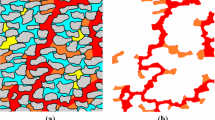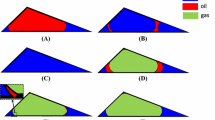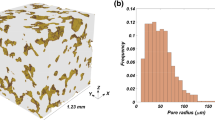Abstract
A recently introduced subphase framework for modeling the nonwetting phase relative permeability is extended to the wetting phase. Within this framework, the wetting phase is divided into four subphases, which are distinguished by their connectivity; backbone, dendritic, isolated and corner-film subphases. The subphase saturations evolve according to inter-subphase volume transfer terms, which require modeling. An advantage of distinguishing the subphases is that wetting phase relative permeability relations as functions of these constituent subphases can be developed. In order to develop models for the inter-subphase volume transfer and the wetting phase relative permeability in a strongly wetted system, quasi-static flow simulations in pore networks were conducted to analyze the evolution of the wetting subphases during drainage and imbibition. The simulation results suggest that hysteresis trends apparent in experimentally obtained wetting phase relative permeability curves for Berea sandstone may be explained by accounting for corner-film flow.
Similar content being viewed by others
References
Akbarabadi, M., Piri, M.: Relative permeability hysteresis and capillary trapping characteristics of supercritical co 2/brine systems: an experimental study at reservoir conditions. Adv. Water Resour. 52, 190–206 (2013)
Arns, J.Y., Arns, C.H., Sheppard, A.P., Sok, R.M., Knackstedt, M.A., Pinczewski, W.V.: Relative permeability from tomographic images; effect of correlated heterogeneity. J. Pet. Sci. Eng. 39(3), 247–259 (2003)
Arns, J.Y., Robins, V., Sheppard, A.P., Sok, R.M., Pinczewski, W., Knackstedt, M.A.: Effect of network topology on relative permeability. Transp. Porous Media 55(1), 21–46 (2004)
Bakke, S., ØRen, P.: 3-d pore-scale modelling of sandstones and flow simulations in the pore networks. SPE J. 2(2), 136–149 (1997)
Bear, J.: Dynamics of fluids in porous media. In: Dynamics of Fluids in Porous Media. American Elsevier (1967)
Bennion, B., Bachu, S., et al.: Relative permeability characteristics for supercritical Co2 displacing water in a variety of potential sequestration zones. In: SPE Annual Technical Conference and Exhibition. Society of Petroleum Engineers (2005)
Benson, S., Pini, R., Reynolds, C., Krevor, S.: Relative permeability analysis to describe multi-phase flow in co2 storage reservoirs Global CCS Institute (2013)
Berg, S., Armstrong, R., Georgiadis, A., Ott, H., Schwing, A., Neiteler, R., Brussee, N., Makurat, A., Rucker, M., Leu, L.: Onset of oil mobilization and nonwetting-phase cluster-size distribution. Petrophysics 56(01), 15–22 (2015)
Blunt, M.J.: Effects of heterogeneity and wetting on relative permeability using pore level modeling. SPE J. 2(01), 70–87 (1997)
Blunt, M.J.: Flow in porous media - pore-network models and multiphase flow. Current opinion in colloid & interface science 6(3), 197–207 (2001)
Blunt, M.J., Jackson, M.D., Piri, M., Valvatne, P.H.: Detailed physics, predictive capabilities and macroscopic consequences for pore-network models of multiphase flow. Adv. Water Resour. 25(8), 1069–1089 (2002)
Blunt, M.J., Jackson, M.D., Piri, M., Valvatne, P.H.: Detailed physics, predictive capabilities and macroscopic consequences for pore-network models of multiphase flow. Adv. Water Resour. 25(8), 1069–1089 (2002)
Carlson, F.: Simulation of relative permeability hysteresis to the nonwetting phase. In: SPE Annual Technical Conference and Exhibition (1981)
Constantinides, G.N., Payatakes, A.C.: Network simulation of steady-state two-phase flow in consoliyeard porous media. AIChE J 42(2), 369–382 (1996)
Dias, M.M., Payatakes, A.C.: Network models for two-phase flow in porous media part 1. Immiscible microdisplacement of non-wetting fluids. J. Fluid Mech. 164, 305–336 (1986)
Fatt, I.: The network model of porous media (1956)
Gunstensen, A.K., Rothman, D.H.: Lattice-boltzmann studies of immiscible two-phase flow through porous media. Journal of Geophysical Research: Solid Earth 98(B4), 6431–6441 (1993)
Herring, A.L., Harper, E.J., Andersson, L., Sheppard, A., Bay, B.K., Wildenschild, D.: Effect of fluid topology on residual nonwetting phase trapping: implications for geologic co 2 sequestration. Adv. Water Resour. 62, 47–58 (2013)
Hilfer, R.: Macroscopic capillarity without a constitutive capillary pressure function. Physica A: Statistical Mechanics and its Applications 371(2), 209–225 (2006)
Hilfer, R., ØRen, P.: Dimensional analysis of pore scale and field scale immiscible displacement. Transp. Porous Media 22(1), 53–72 (1996)
Huang, H., Meakin, P., Liu, M.: Computer simulation of two-phase immiscible fluid motion in unsaturated complex fractures using a volume of fluid method. Water Resour. Res. 41(12) (2005)
Idowu, N.A., Blunt, M.J.: Pore-scale modelling of rate effects in waterflooding. Transp. Porous Media 83(1), 151–169 (2010)
Jerauld, G., Salter, S.: The effect of pore-structure on hysteresis in relative permeability and capillary pressure: pore-level modeling. Transp. Porous Media 5(2), 103–151 (1990)
Joekar-Niasar, V., Hassanizadeh, S., Dahle, H.: Non-equilibrium effects in capillarity and interfacial area in two-phase flow: dynamic pore-network modelling. J. Fluid Mech. 655(1), 38–71 (2010)
Joekar-Niasar, V., Hassanizadeh, S.M.: Uniqueness of specific interfacial area–capillary pressure–saturation relationship under non-equilibrium conditions in two-phase porous media flow. Transp. Porous Media 94(2), 465–486 (2012)
Khayrat, K.: Modeling hysteresis for two-phase flow in porous media: from micro to macro scale. Ph.D. thesis, Dissertation, ETH-zürich, 2016, Nr.23273 (2016)
Khayrat, K., Jenny, P.: Subphase approach to model hysteretic two-phase flow in porous media. Transp. Porous Media 111(1), 1–25 (2016)
Killough, J.: Reservoir simulation with history-dependent saturation functions. Old SPE J 16(1), 37–48 (1976)
Land, C.S.: Calculation of imbibition relative permeability for two-and three-phase flow from rock properties. Soc. Pet. Eng. J 8(02), 149–156 (1968)
Lenormand, R., Zarcone, C., Sarr, A.: Mechanisms of the displacement of one fluid by another in a network of capillary ducts. J. Fluid Mech. 135, 337–353 (1983)
Li, X., Zhang, Y., Wang, X., Ge, W.: Gpu-based numerical simulation of multi-phase flow in porous media using multiple-relaxation-time lattice boltzmann method. Chem. Eng. Sci. 102, 209–219 (2013)
Moebius, F., Or, D.: Inertial forces affect fluid front displacement dynamics in a pore-throat network model. Phys. Rev. E. 90(2), 023–019 (2014)
Oak, M., Baker, L., Thomas, D.: Three-phase relative permeability of berea sandstone. J. Petrol. Tech. 42(08), 1–054 (1990)
Øren, P., Bakke, S., Arntzen, O.: Extending predictive capabilities to network models. SPE J 3, 324–36 (1998)
Raeini, A.Q., Blunt, M.J., Bijeljic, B.: Direct simulations of two-phase flow on micro-ct images of porous media and upscaling of pore-scale forces. Adv. Water Resour. 74, 116–126 (2014)
Ransohoff, T., Radke, C.: Laminar flow of a wetting liquid along the corners of a predominantly gas-occupied noncircular pore. J. Colloid Interface Sci. 121(2), 392–401 (1988)
Reeves, P.C., Celia, M.A.: A functional relationship between capillary pressure, saturation, and interfacial area as revealed by a pore-scale network model. Water Resour. Res. 32(8), 2345–2358 (1996)
Sahimi, M., Imdakm, A.: The effect of morphological disorder on hydrodynamic dispersion in flow through porous media. J. Phys. A Math. Gen. 21(19), 3833 (1988)
Schlüter, S., Berg, S., Rücker, M., Armstrong, R., Vogel, H.J., Hilfer, R., Wildenschild, D.: Pore-scale displacement mechanisms as a source of hysteresis for two-phase flow in porous media. Water Resources Research (2016)
Singh, K., Bijeljic, B., Blunt, M.J.: Imaging of oil layers, curvature, and contact angle in a mixed-wet and a water-wet carbonate rock. Water Resources Research (2016)
Tokunaga, T.K.: Physicochemical controls on adsorbed water film thickness in unsaturated geological media. Water Resour. Res. 47(8) (2011)
Tomin, P., Lunati, I.: Hybrid multiscale finite volume method for two-phase flow in porous media. J. Comput. Phys. 250, 293–307 (2013)
Tsakiroglou, C., Aggelopoulos, C., Terzi, K., Avraam, D., Valavanides, M.: Steady-state two-phase relative permeability functions of porous media: a revisit. Int. J. Multiphase Flow 73, 34–42 (2015)
Wilkinson, D., Willemsen, J.F.: Invasion percolation: a new form of percolation theory. J. Phys. A Math. Gen. 16(14), 3365 (1983)
Acknowledgments
The authors would like to acknowledge Soheil Esmaeilzadeh for conducting preliminary pore-network simulations of the wetting subphase saturations during a semester project at ETH Zurich. The authors would also like to thank Total SA for financial support of this work.
Author information
Authors and Affiliations
Corresponding author
Rights and permissions
About this article
Cite this article
Khayrat, K., Jenny, P. Modeling wetting-phase relative permeability hysteresis based on subphase evolution. Comput Geosci 21, 863–875 (2017). https://doi.org/10.1007/s10596-017-9655-y
Received:
Accepted:
Published:
Issue Date:
DOI: https://doi.org/10.1007/s10596-017-9655-y




